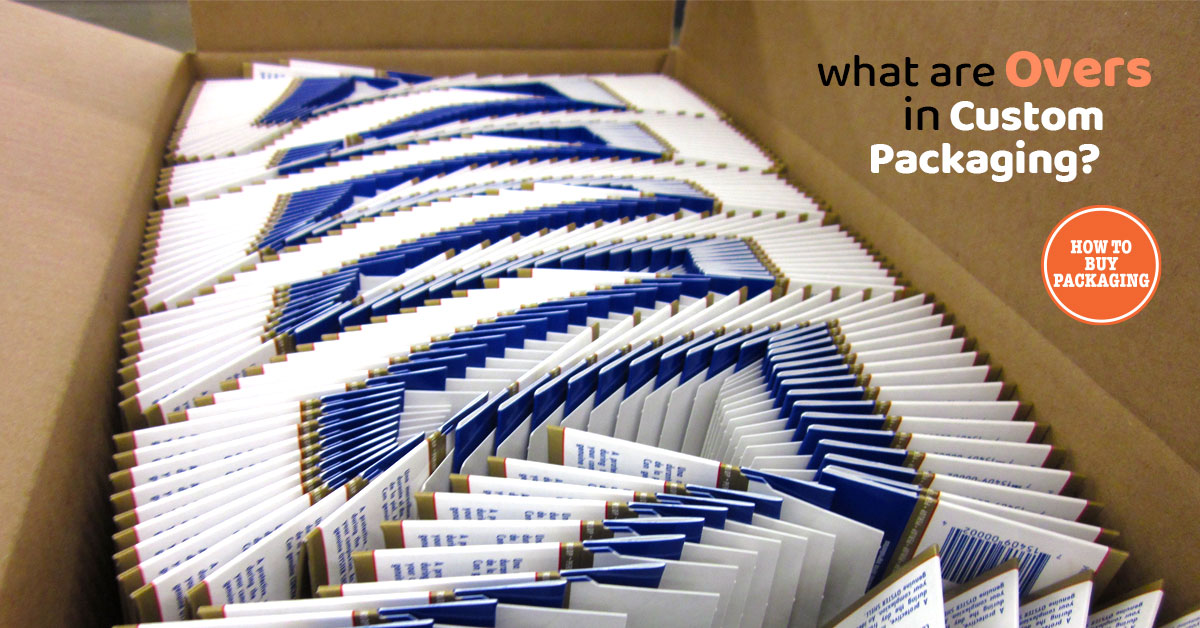Overs is a term you will hear when you buy custom packaging. But what are overs? And for that matter, what are unders? Custom packaging is a manufacturing process. And with all manufacturing there are margins of error estimated into every job. Typically, this margin is 10% plus or minus the quantity you order.
If all goes well with the job, then the 10% over the quantity ordered is referred to as “Overs”. Likewise, the 10% under the quantity ordered is called “Unders“.
WHAT ARE OVERS? (10% Plus)
When you are signing off or agreeing to job terms, and may see on the contract “10% plus“. This means that you will agree to purchase up to 10% over the original quantity if all goes well. This is standard for all custom packaging manufacturers. However, you do have a choice as to whether you want to purchase this 10% over the initial quantity. But this is a decision you have to make at the signing of the contract. And rest assured, if you decide not to pay for the 10% over, the manufacturer will recoup those margin of error costs by padding the price of your order in other ways. So it’s advantageous to you, the buyer, to purchase the 10% over.
WHAT ARE UNDERS? (10% Minus)
“10% under” means that you agree to accept 10% less than the original quantity ordered in case there are manufacturing errors, but no more than 10%. So you are guaranteed 90% of your order. And you will only pay for what they ship to you. So if they are able to produce 95% of your order, you will only be billed for that 95%.
OVERS AND UNDERS – An Example Scenario
Let’s say you want to order around 10,000 units of custom packaging. You get a price quote for 10,000 units at $1.00/unit.
Now, 10% overs means that you may receive up to 11,000 units but no less than 10,000 units. So if the manufacturer makes mistakes on 500 units (5% of the total order), you will receive 10,500 units and be charged for 10,500 units. If they make mistakes on 1,100 units (11% of the total order), you will still receive 10,000 units as agreed upon and only be charged for those 10,000 units (the manufacturer would have to absorb the loss of the 100 units (that extra 1% ).
So, if I want “approximately” 10,000 units, why not just order 9000 units and, depending on how many mistakes the manufacturer makes, I should end up with anywhere between 9,000-10,000 units?
Well, the reason you may not want to do this is because the per unit price would probably be more expensive the less you order. So ordering 10,000 units may cost you (as in the example above) $1/unit and ordering 9,000 units may cost you $1.10/unit.
It would be better then to do 10% unders. This way you would, in fact, receive anywhere from 9,000 to 10,000 units. And you would only pay for what you receive.
NOTE: in most cases the standard or default for most manufacturers is “Overs“, not “Unders“. So unless you request “unders”, “overs” will be what you are going to agree to pay for. So if you want “unders”, you need to specifically request it.
If you don’t see “overs” mentioned on the price quote or estimate, inquire about it, just so you get the full picture.
If you do not want to agree to these terms, you should let the manufacturer know ahead of the estimate, in which case more material is added into the price to assure you will get the quantity you are asking for. But again, refusing to accept the terms of overs or unders isn’t really advantageous to you, the buyer.
This has been a part of my tutorial series called How to Buy Packaging 101. So click the link below to head back if you haven’t finished reading it yet. 🙂

